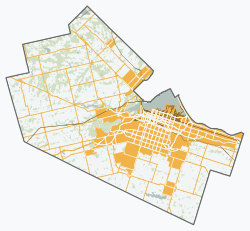
Tinawatawa, also called Quinaouatoua, was an Iroquois village of the Seneca people on the western end of the Niagara corridor, described as "a fertile flat belt of land stretching from western New York to the head waters of the Thames River". It was located on the western end of Lake Ontario.
Location

There are a number of theories about where the village was located. One theory is that it was east or northeast of present-day Westover, Ontario, on the north side of Spencer Creek and in Beverly Swamp, which was a winter hunting grounds site. From archaeological studies of what was called the Christianson Site, it was occupied about 1615 to 1630 by Iroquois people.
Other theories are that Tinawatawa was along Ancaster Creek in Ancaster, Ontario, between Dundas and Brantford. It may have been in current day West Flamborough on the Grand River along a high ground trail that is now Regional Road 97. Or, more probably, halfway to Brantford and the Grand River.
History
In the 17th century, what is now Southern Ontario was Huronia. The Lower Great Lakes and Huronia "region was a multicultural landscape composed of conquerors, refugees and dispersed peoples." The Dutch, French, and English competed for trade alliances with indigenous peoples. Explorers and cartographers passed through the area. The Beaver Wars involved Iroquois and Algonguian speaking people. In the 1660s, Tinawatawa was part of the territory held by the Iroquois, but others traveled or ranged through the area. From 1660 to 1690, Tinawatawa was a hub village.
On September 24, 1669, Louis Jolliet and explorer René-Robert Cavelier, Sieur de La Salle met with René de Bréhant de Galinée, François Dollier de Casson, superior of the Sulpicians, and other Sulpicians of Montreal, who were missionaries. The missionaries were exploring the western frontier and looking for a place to establish a mission. They stopped at Tinawatawa to find a guide to take them to the western frontier.
There were 30 years of skirmishes following the 1669 meeting. Tinawatawa was subject to attacks by the French and Ojibwe. By 1701, most of the Iroquois withdrew from southern Ontario.
The original five nations of the Iroquois Confederacy reused former settlements in Southern Ontario, including Tinawatawa, also called Quinaouotuan and Tinaouatoua, or Otinawatawa by historian Francis Parkman.
Notes
- Until the 1960s, it was believed to have been in Aldershot, Ontario near La Salle Park and along the northern shore of Lake Ontario.
References
- ^ "Speculations on the Seneca Outpost of Tinawatawa - Vignette". Flamborough Archives And Heritage Society. 2018-08-24. Archived from the original on 2023-12-04. Retrieved 2024-10-22.
- ^ "La Salle's journey - the landing". FlamboroughReview.com. Retrieved 2021-06-02.
- ^ Schmalz, Peter S. (1991-01-01). The Ojibwa of Southern Ontario. University of Toronto Press. ISBN 978-0-8020-6778-4.
- ^ Kellogg, Louise Phelps (2007). The French Regime in Wisconsin and the Northwest. Heritage Books. p. 133. ISBN 978-0-7884-1766-5.
- ^ Henderson, Bob; Bandow, James B. (Summer 2009). "Watch Your Step: Where was Tinawatawa?" (PDF). Ontario Professional Surveyor.
| League of the Iroquois | |
|---|---|
| Peoples | |
| Topics | |
| Iroquois du Nord Iroquois settlement of the northern shores of Lake Ontario | |
|---|---|
| Iroquois villages | |